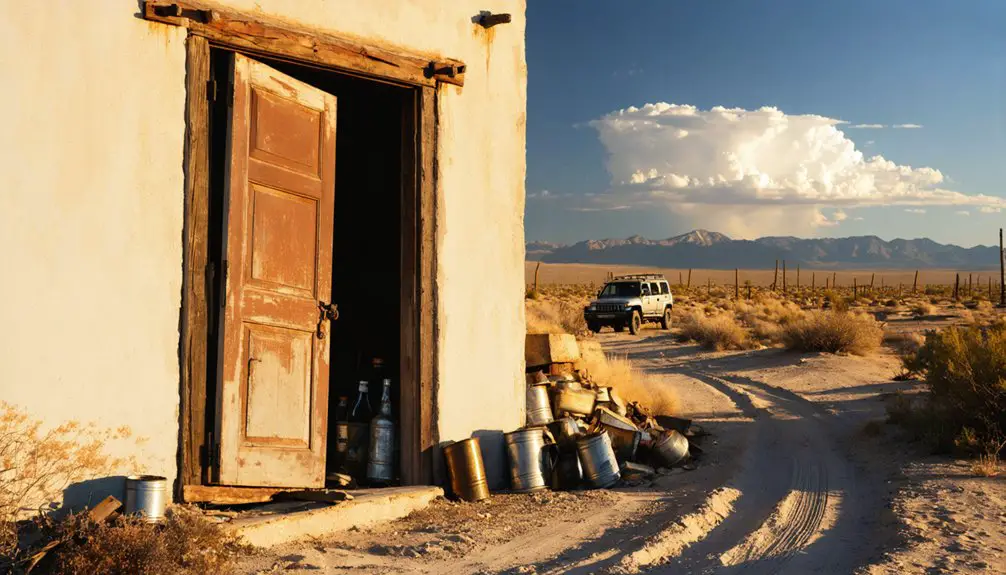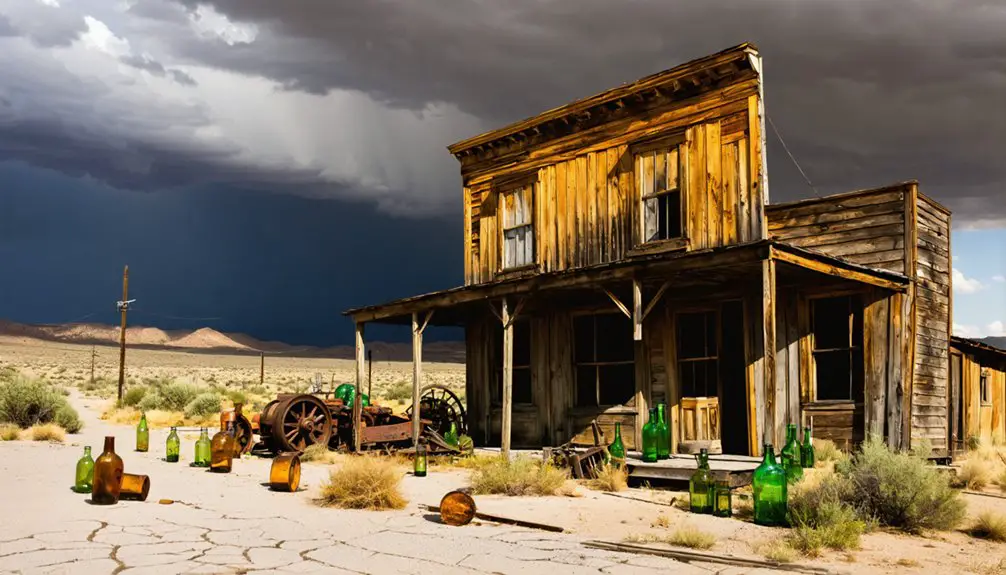You’ll discover Alturas, Nevada as a tribute to the American West’s mining legacy, established after William Prous’s 1850 gold discovery. The town flourished with sophisticated amenities including electric lines, plumbing, and a Mission Revival railroad depot that served as an essential transportation hub. While mining hazards and economic challenges ultimately led to its abandonment, Alturas’s preserved sandstone structures and archaeological remnants offer compelling insights into Nevada’s boom-and-bust frontier era.
Key Takeaways
- Alturas was a mining boomtown in Nevada that flourished during the late 19th century due to significant gold and silver discoveries.
- The town’s prosperity centered around its role as a transportation hub, featuring the Nevada-California-Oregon Railway headquarters established in 1908.
- Notable architectural features include a Mission Revival railroad headquarters, native sandstone courthouse, and historic jail with distinctive iron features.
- Economic decline occurred due to water shortages, declining ore quality, and financial crises in 1893 and 1907.
- The ghost town remains accessible via rural roads but requires careful preparation and four-wheel drive vehicles for exploration.
The Discovery and Settlement Years
As the California Gold Rush drew thousands westward in 1849, early prospector Abner Blackburn made Nevada’s first significant gold discovery, setting the stage for Alturas’s eventual founding.
When William Prous uncovered another gold vein in Gold Canyon the following year, you’d have witnessed the beginnings of Nevada’s own mining fever, though many prospectors still favored California’s richer claims.
Like the bustling settlement of Wild West Vein that would emerge in 1863 at Aurora, these early discoveries sparked waves of fortune seekers to the region. The success of mining towns like Rhyolite’s Train Depot proved vital for transporting ore and supplies across the harsh Nevada terrain.
Life During the Mining Boom
If you’d entered Alturas during its mining heyday, you’d have found hundreds of miners laboring underground in hazardous conditions, using hand drills and basic blasting techniques to extract precious metals.
After grueling shifts, workers sought refuge in the town’s saloons and gambling halls, which served as crucial social hubs in the mainly male community.
Living conditions remained rudimentary throughout the boom years, with most miners residing in basic wooden shacks that offered little protection from the harsh Nevada elements while struggling with poor sanitation and limited water access. A devastating mine fire claimed 17 lives at a nearby Belmont operation in 1911, highlighting the constant dangers faced by mining communities. The mines reached their most productive period during the post-war industrial expansion, when demand for metals soared and operations intensified.
Daily Life Underground
While the promise of striking it rich drew countless prospectors to Alturas, Nevada, the harsh realities of daily underground mining life quickly dispelled romantic notions of easy wealth.
You’d spend 10-12 grueling hours in narrow tunnels, where your carbide lamp offered minimal visibility as you faced constant underground hazards.
Your daily routines involved:
- Drilling and blasting with black powder or dynamite
- Mucking ore in poorly ventilated shafts
- Installing timber supports to prevent cave-ins
- Traversing extreme temperatures and toxic gases
- Operating in confined spaces with limited escape routes
These challenging conditions took their toll on miners’ health, with respiratory diseases and injuries commonplace. The clash between professional miners and speculators created additional tensions in the dangerous underground workspace. During World War I, miners endured even longer shifts as essential materials were desperately needed for military production.
The physical demands required exceptional endurance, technical skill, and a willingness to risk everything in pursuit of precious metals beneath the earth’s surface.
Saloons and Social Scene
The bustling saloons of Alturas served as vibrant social hubs where miners sought refuge from their grueling underground work. You’d find these establishments buzzing with activity late into the night, as workers from different shifts gathered to drink, gamble, and share news about recent mineral discoveries.
The saloons’ influence extended beyond mere entertainment, functioning as informal employment centers and venues for community celebrations. Most patrons were part of the several hundred men who found employment during the area’s brief mining boom.
Inside these wooden-framed establishments, you’d encounter a distinctly male-dominated atmosphere where gambling culture thrived. Poker and faro tables attracted miners wagering their earnings, while live music and dance halls provided essential entertainment.
These venues helped circulate mining wealth throughout the community, with owners often holding significant social and political influence. Despite occasional violence and moral concerns, saloons remained central to Alturas’s frontier society.
Workers’ Living Conditions
Beyond the lively atmosphere of Alturas’s saloons lay the stark reality of miners’ daily existence. The housing conditions you’d have encountered would’ve tested your resilience, with cramped quarters shared among multiple workers in hastily constructed shacks and cabins.
You’d find yourself living within walking distance of the mines, trading comfort for convenience during those grueling 12-hour shifts.
- Makeshift shelters built from local wood and corrugated metal
- Overcrowded spaces shared by multiple miners
- Minimal or non-existent sanitation facilities
- Basic accommodations provided by mining companies
- Close proximity to hazardous mining operations
The miners’ health suffered severely from these living arrangements, with poor ventilation and sanitation leading to frequent disease outbreaks.
You’d have faced daily exposure to toxic substances while working, compounded by the unsanitary conditions at home.
Transportation Hub and Railroad Legacy
Narrow-gauge rails carved through the high desert marked Alturas’ transformation into a significant transportation nexus during the late 19th and early 20th centuries.
You’ll find the railroad’s importance reflected in the 1908 arrival of the Nevada-California-Oregon Railway, which established Alturas as an essential terminus. The town offered $10,000 and 20 acres to relocate the N.C.O. headquarters there. The Queen Anne style depot, built from local quarry stone, became a landmark of the town’s railway heritage. The town’s strategic positioning enhanced freight logistics throughout the region, connecting previously isolated high desert and ranch lands.
When Southern Pacific acquired the line in 1926, you’d witness the conversion from narrow to standard gauge, integrating Alturas into the broader U.S. rail network.
Though passenger service ended in 1938, the Modoc Line continued serving as a strategic freight corridor.
Today, while much of the line stands abandoned, you can still see remnants of Alturas’ railroad legacy in its preserved depot and remaining tracks used for freight storage.
Architecture and Notable Structures

While many ghost towns showcase modest frontier architecture, Alturas stands apart through its remarkable collection of preserved structures that span commercial, civic, and residential buildings from the early 1900s.
The town’s architectural legacy reveals the prosperity of its mining heyday, with impressive commercial buildings like the Cook Bank Building leading the way. Multiple railroads once connected here, with the Las Vegas and Tonopah providing vital transportation links.
- Cook Bank Building, completed in 1908 for over $90,000, featured dual vaults and a basement post office
- Historic courthouse built of native sandstone, adorned with original Tiffany & Co. lamps
- N.C.O. Railroad’s Mission Revival headquarters with its distinctive bell tower
- Stone and wood residential structures ranging from modest homes to elaborate mansions
- 1907 jail construction demonstrating sturdy stone craftsmanship with distinctive iron features
Today, you’ll find these architectural remnants telling stories of wealth, ambition, and the dramatic rise and fall of this once-thriving Nevada boomtown.
Economic Rise and Decline
During the late 19th century, Alturas experienced a dramatic economic surge as mining companies rushed to exploit the region’s promising silver and gold deposits. The economic impact was transformative, as companies like Tonopah-Belmont invested heavily in infrastructure, including railroads, mills, and worker housing.
You’d have found a bustling town with electric lines, plumbing, and diverse businesses from hotels to hospitals.
However, the boom wouldn’t last. Despite attempts to improve mining technology, the region faced significant challenges. Water shortages forced mills to operate dry, spreading harmful dust, while ore quality failed to meet expectations.
When extraction costs exceeded profits, mines began closing. The financial crises of 1893 and 1907 dealt additional blows, triggering mass exodus. Businesses shuttered, services discontinued, and Alturas’s transformation into a ghost town became inevitable.
Modern-Day Exploration and Access

Despite its remote location in northern Nevada, Alturas Ghost Town remains accessible to modern-day explorers through a network of rural roads.
You’ll need to prepare thoroughly for your visit, as the site’s isolation demands careful planning and proper equipment. Ghost town photography enthusiasts can utilize online resources, including specialized GPS coordinates and interactive maps, to navigate to the site effectively.
- Four-wheel drive vehicles are recommended, especially after adverse weather
- Bring sufficient water, food, and emergency supplies for extended exploration
- Check local regulations and private property boundaries before visiting
- Carry offline maps or GPS devices due to limited cell coverage
- Consider nearby towns as base camps for supplies and lodging
The site’s growing popularity among explorers has led to improved documentation and mapping, though you’ll still need to exercise caution around structural hazards and wildlife while exploring this historic location.
Preservation and Historical Significance
As one of Nevada’s significant mining-era settlements, Alturas Ghost Town has garnered substantial attention from preservation organizations and historical societies dedicated to protecting its architectural heritage.
You’ll find the site protected under state preservation laws that restrict demolition and alterations of surviving structures, while community involvement through volunteer restoration projects helps maintain the town’s authenticity.
The site faces numerous preservation challenges, including harsh weather conditions, vandalism, and limited funding.
Despite these obstacles, local historical societies continue documenting artifacts, maintaining interpretive signage, and conducting educational programs.
Archaeological surveys reveal insights into frontier building techniques and daily mining life, while museums curate discovered artifacts.
The town’s significance extends beyond its physical structures, serving as an essential example of Nevada’s boom-and-bust mining cycles and early economic development.
Frequently Asked Questions
Are There Any Reported Ghost Sightings or Paranormal Activity in Alturas?
You’ll discover numerous ghost encounters throughout Hotel Niles, where paranormal investigations reveal shadowy figures, disembodied voices, and a mysterious woman’s apparition that’s left visitors fleeing in terror.
Is Camping Allowed Near the Ghost Town Ruins?
You can’t camp directly at the ruins. Current camping regulations require you to use designated sites on public lands or get written permission from private landowners near the ghost town.
What Wildlife Can Visitors Expect to Encounter in the Area?
You’ll find excellent wildlife observation opportunities including desert bighorn sheep, mountain lions, various foxes, and over 230 bird species. Photography opportunities are best during spring migrations of waterfowl.
Are Metal Detectors Permitted for Treasure Hunting Around Alturas?
You’ll need written permits for metal detecting in this area. Without proper BLM authorization, treasure hunting isn’t permitted near historic sites. Focus on private lands with owner permission instead.
Which Nearby Towns Offer Food, Gas, and Lodging Services?
While small towns dot the landscape, you’ll find local dining and fuel stations primarily in Alturas and Cedarville, CA. For more options, head to Susanville or Lakeview, OR for full services.
References
- https://www.youtube.com/watch?v=znYWZIDO6bA
- https://en.wikipedia.org/wiki/Alturas
- https://nvtami.com/2025/02/21/highway-395-ghost-towns-reno-to-lakeview/
- https://www.atlasobscura.com/places/aurora-nevada
- https://en.wikipedia.org/wiki/List_of_ghost_towns_in_Nevada
- https://travelnevada.com/ghost-town/aurora-ghost-town/
- https://www.youtube.com/watch?v=opD2zxGhNtg
- https://travelnevada.com/ghost-town/
- https://www.youtube.com/watch?v=EXNXO4mYhw0
- https://nbmg.unr.edu/mining/MiningHistory.html



